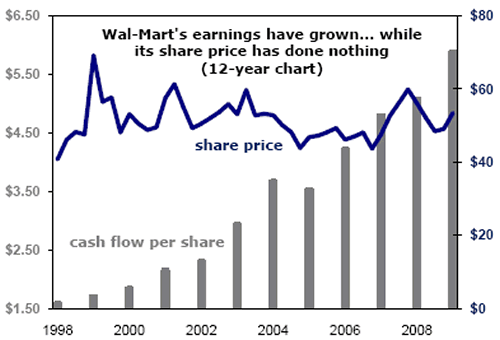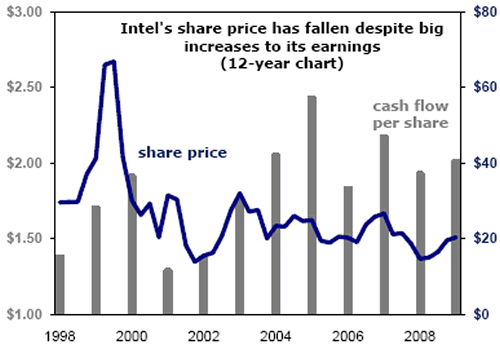Why You Should Begin Buying the World's Safest Stocks
Companies / Investing 2010 Jul 17, 2010 - 02:24 AM GMTBy: DailyWealth
 Porter Stansberry writes: This month, I faced one of the most difficult choices of my career as an investment analyst.
Porter Stansberry writes: This month, I faced one of the most difficult choices of my career as an investment analyst.
If you've been reading my Investment Advisory or DailyWealth for more than a month, you probably know I'm concerned with exploding levels of government debt in Europe and the United States. Western governments have taken on obligations they cannot possibly hope to repay. The outcome will be a severe devaluation of their paper currencies. You can read some of my thoughts on this subject here.
Now, this is where it gets difficult...
Despite all of the world's credit and currency problems, many of the market's highest-quality companies are once again trading for extremely attractive prices, thanks to the fall in stock prices during the second quarter.
The question that's keeping me up at night isn't whether or not the currency crisis we're experiencing will worsen. I know it will. What keeps me up at night now is wondering whether or not by focusing so much on the risks, I could be missing the opportunities this crisis has created.
You see, despite the huge risks to the global economy, I know it's unlikely that everything will grind to a complete halt or that a new, global war will break out. Having been a leader in warning about the impending sovereign debt crisis, I'm now trying to lead my readers in a new direction – the incredible value presenting itself in the form of the world's biggest global companies.
We begin with a conclusion you might find surprising: Only rarely in history have the world's largest and best corporations been for sale at lower prices. Furthermore, buying blue-chip stocks at these super-low valuations has historically always led to outstanding returns. In short, high-quality stocks are amazingly cheap. And you're probably foolish if you don't at least start to buy.
The chart below shows you the share price of Wal-Mart – the world's leading retailer – compared to its earnings.

As you can plainly see, over the last 12 years, the stock price of Wal-Mart has done exactly nothing. Meanwhile, its earnings have continued to grow, almost every single year, by large amounts.
Wal-Mart is now earning more than $26 billion annually in cash. It is returning roughly $12 billion to shareholders (via dividends and buybacks) and spending $12 billion building new stores or improving old ones. The remaining balance of its cash earnings is going toward repaying debt – almost $2 billion was retired last year.
And yet... the company's entire market value is now $190 billion. That is, if Wal-Mart applied all of its capital toward buying stock, it could take itself private in a little over seven years – assuming no additional growth whatsoever. Given its recent growth rates, it could likely accomplish this goal in something around five years.
A reasonable analyst, adjusting for Wal-Mart's unique resilience and long history of earnings growth, would assign the company a forward earnings multiple of something between five and seven. Meanwhile the stock is currently yielding more than 6%, when you adjust the cash dividends for the share buybacks. In short, Wal-Mart now has an earnings multiple that's roughly the same number as its yield, a situation that is extremely rare in the world's highest-quality stocks.
At the bottom of the stock market in 1932, the S&P 500 traded for less than 10 times earnings and yielded roughly 10%. At the bottom of the market in 1974, the S&P 500 traded at seven or eight times earnings and was yielding nearly that much in income (6.5%). And at the market bottom in 1982, stocks were again trading for around six times earnings, while the dividend yield had increased to almost 7%.
In short, Wal-Mart's valuation suggests we are approaching a bottom in high-quality stocks. While this isn't true – yet – for the market as a whole (today the S&P 500 yields just over 2% in cash and is trading at 17 times earnings), it is true of the market's best companies.
Take a look at Intel, for another example.

Intel's growth isn't as uniform as Wal-Mart's. But its share price has actually fallen substantially over the last 12 years, despite big increases to its earnings. Intel's CEO, Paul Otellini, said the most recent quarter was the best in Intel's entire history, with revenue of $10.8 billion – up 34% from last year's second quarter. And yet, despite these record results, Intel's stock price remains near $20 – down from $70 in the late 1990s. Let me show you what that means in terms of current valuation...
I expect Intel will earn something around $15 billion this year in cash. After spending roughly $4 billion building new factories and expanding old ones, Intel will have $11 billion left over for debt repayment and distributions. Given that it only holds $2 billion in debt, I doubt any of this cash will go toward debt repayment. But to be conservative, let's assume Intel decides to repay half of its debt. That implies it will return something around $10 billion to shareholders. (These aren't pie-in-the-sky figures. In 2008, Intel returned more than $9 billion to shareholders.)
Given Intel's $100 billion market value, my forecast is Intel will yield something around 10% to equity investors this year, including both cash dividends and stock buybacks. Meanwhile, the company is trading at a cash-earnings multiple of less than seven.
I can't stress enough how unusual it is for super-high-quality stocks to be paying dividend yields that are actually bigger than their earnings multiple. Opportunities to buy stocks at such low prices only occur around market bottoms.
The point, as I'm sure you've gotten by now, is that these companies, which represent some of the finest examples of capitalism in the world, are trading at silly cheap prices. And while I have very real concerns about the well-being of the global economy, I believe these firms will be far more able to weather the coming storm than just about any other kind of asset.
Here we are, 12 years after the peak of stock valuations. All of the best companies, which people were paying crazy prices to own in their 401k accounts back then, have executed either as well – or better – than any reasonable projection would have forecast. The companies earned the money they were expected to earn – sometimes more. And yet today, with these companies vastly richer, better managed, and in better competitive positions, suddenly investors don't want them anymore.
While I don't believe the stock market in general is a good buy, I do believe now is the time to buy these incredible businesses nobody else wants.
Good investing,
Porter Stansberry
P.S. I encourage you to read the latest issue of my Investment Advisory (out yesterday) for my favorite way to invest in this idea. It involves buying one of the greatest companies in the history of capitalism for an absurdly cheap price. If you're looking for a safe way to make a lot of money, it's a great opportunity. You can learn how to access this issue immediately here.
The DailyWealth Investment Philosophy: In a nutshell, my investment philosophy is this: Buy things of extraordinary value at a time when nobody else wants them. Then sell when people are willing to pay any price. You see, at DailyWealth, we believe most investors take way too much risk. Our mission is to show you how to avoid risky investments, and how to avoid what the average investor is doing. I believe that you can make a lot of money – and do it safely – by simply doing the opposite of what is most popular.
Customer Service: 1-888-261-2693 – Copyright 2010 Stansberry & Associates Investment Research. All Rights Reserved. Protected by copyright laws of the United States and international treaties. This e-letter may only be used pursuant to the subscription agreement and any reproduction, copying, or redistribution (electronic or otherwise, including on the world wide web), in whole or in part, is strictly prohibited without the express written permission of Stansberry & Associates Investment Research, LLC. 1217 Saint Paul Street, Baltimore MD 21202
Disclaimer: The above is a matter of opinion provided for general information purposes only and is not intended as investment advice. Information and analysis above are derived from sources and utilising methods believed to be reliable, but we cannot accept responsibility for any losses you may incur as a result of this analysis. Individuals should consult with their personal financial advisors.
Daily Wealth Archive |
© 2005-2022 http://www.MarketOracle.co.uk - The Market Oracle is a FREE Daily Financial Markets Analysis & Forecasting online publication.



